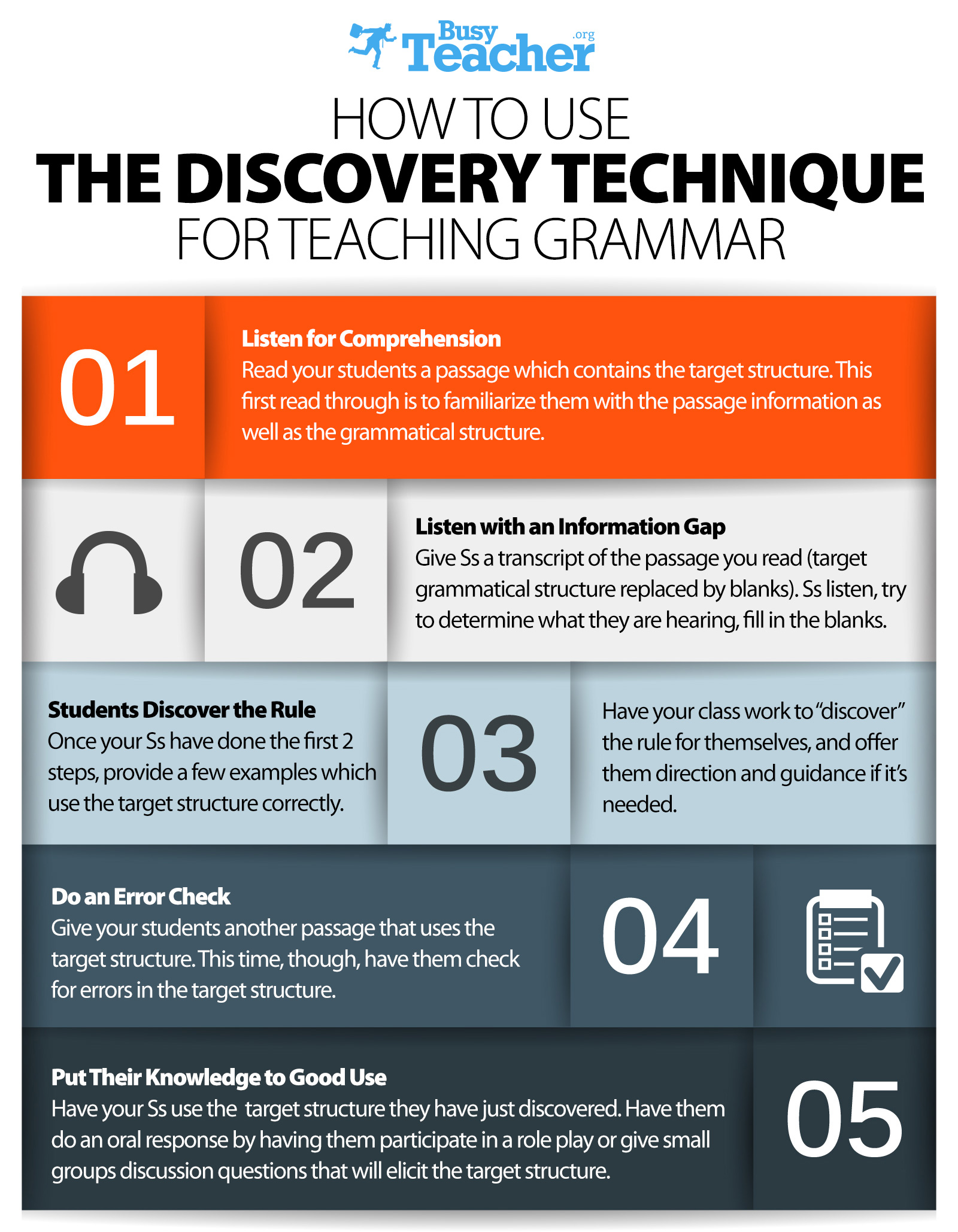Present, Practice, Produce: 4 Go to Strategies for Teaching Language Concepts


Have you tried it? If your answer to either of these questions is no, read on to learn everything you need to know about this simple but effective instruction method.

If you have heard the name of the technique, you can probably get a good understanding of what this not so common teaching method is like. The discovery technique is a method of teaching in which students are not directly presented with a target grammatical structure or rule. Instead, students are given content in which the target structure is used. Students then discover the grammatical rule or figure out the pattern for themselves. The teacher’s role is to guide students to their own discovery, not to give students the information on the grammar rule.

The discovery technique may seem a lot like task based learning, and sometimes they may look similar since neither presents a grammar lesson upfront and or includes “traditional” grammar exercises, but in fact there are several differences between the two. Task based learning puts a communication exercise before students and does not stress the grammar necessary for this task. The discovery technique, on the other hand, does focus on a particular grammar point, and the goal of the lesson is to learn that point. The point of the lesson is to elicit a grammar rule from the students and not complete a communication task. So although there is no direct lecture on a grammar point, the discovery technique still stresses a target structure to be learned.

With the discovery technique, there is a greater emphasis on implicit knowledge, and that knowledge is attained through implicit instruction. But what does any of that mean? Explicit knowledge is what we often see with ESL students. They are able to explain a particular grammar rule and can complete exercises correctly when those exercises are in isolation (or listed in a grammar book). But when it comes to using language fluently, students with explicit knowledge do not necessarily use that same grammar point correctly in their speech or writing. Students with implicit knowledge, however, do use that particular grammar structure correctly in fluent speech. What they may not be able to do is explain why they are doing what they are doing, that is, explain a grammatical rule. Explicit knowledge often results from explicit instruction, which presents a structure to students and then proceeds to use that structure in specifically designed exercises. Implicit instruction, on the other hand, gives students language in context and then challenges them to figure out the grammar on their own. The teacher’s job is to create the conditions that will elicit the grammar rule from their students. This type of instruction often leads to implicit knowledge.

For those who choose to use it, the discovery technique has three primary benefits. First of all, since students are solving a grammar mystery, they tend to pay more attention and stay more engaged. They are not simply receiving information from someone else. They are discovering it for themselves, and they cannot discover it if they do not first look. Secondly, students who learn with the discovery technique tend to remember the rules of grammar better because they have played a part in discovering them. The final benefit might be the greatest of all. Because they have learned grammar by figuring out the rules from context, students familiar with this technique have an easier time figuring out unfamiliar grammar structures they encounter in the future. This makes them better able to cope when they are faced with some grammar point they did not already learn in class.

The discovery technique, though perhaps not very common among ESL classrooms, is really quite simple to use. Here are the 5 basic steps for teaching a lesson with this method.

Read your students a passage which contains the target structure. This first read through is to familiarize them with the passage information as well as the grammatical structure. For example, if I were teaching a lesson on the past tense, I might tell my students about a vacation I took last summer.
Give your students a transcript of the passage you read, this time with the target grammatical structure replaced by blanks. Students listen and try to determine what they are hearing while making a best guess at filling in the blanks with what they hear. For my past tense lesson, I would give my students a transcript of my vacation story to read along with me. On that transcript, however, I would replace every past tense verb with a blank. As I read the passage to my students again, they would fill in the missing verbs.
Once your students have done the first two steps, give them several examples which use the target structure correctly. Have your class work to “discover” the rule for themselves, and offer then direction and guidance if it’s needed. When teaching my past tense lesson, I might give my students several sentences written in the past tense which use –ed verbs.
Now that your students have listened to the target structure and discovered the rule for themselves, give them another passage that uses the target structure. This time, though, have students check for errors in the targets structure. In my past tense lesson, I might choose to give my students independent sentences or another passage which uses the past tense. In either case, the sentences would have errors throughout which my students would need to correct.
In this final step, have your students use the grammar structure they have just discovered. You might have them do an oral response by having students participate in a role play or give small groups discussion questions that will elicit the target structure. You can also have students do a written response that uses the target structure. For my past tense lesson, I might have students tell a partner about a vacation that they took. Or I might have them write a letter describing their vacation to a friend.
It may seem strange to those of us who were trained to stand up front and present information to our students, but the discovery technique can be a memorable and effective technique for teaching grammar in the ESL classroom. If you have never tried this technique with your students, you may want to. You just might find that the best way to teach is to let students discover the information for themselves.
Share it with us in the comments section below.